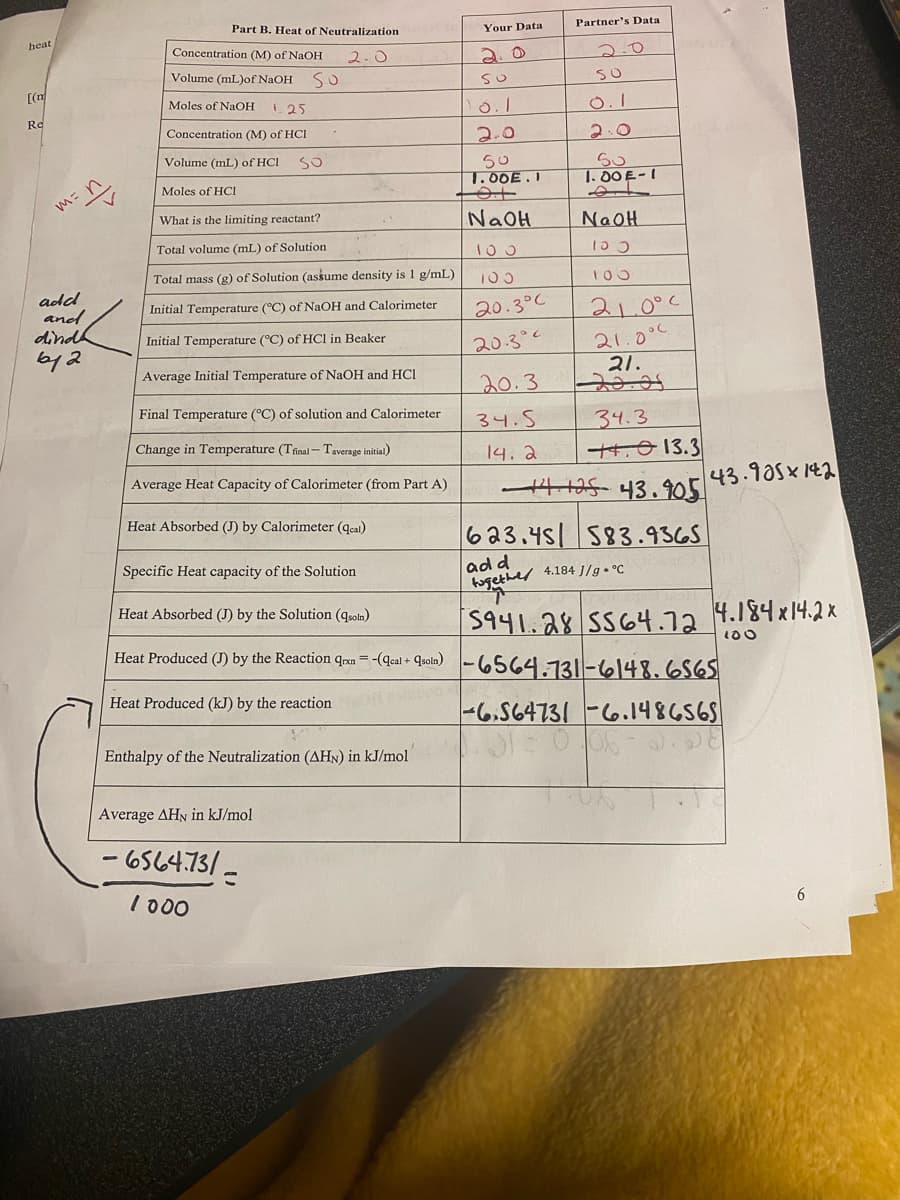Part B. Heat of Neutralization Your Data Partner's Data Concentration (M) of NaOH 2.0 20 2.0 Volume (mL)of NAOH SO so Moles of NaOH 1.25 o.1 0.1 Concentration (M) of HCI 2.0 2.0 Volume (mL) of HCI so 50 T.00E.I 1. 00 E- I Moles of HCI What is the limiting reactant? NaOH NaOH Total volume (mL) of Solution 100 Total mass (g) of Solution (asšume density is 1 g/mL) 105 100 Initial Temperature (°C) of NaOH and Calorimeter 20.3°C 21.0°C ndd Initial Temperature (°C) of HCl in Beaker 21.0°C 21. 20.3°c Average Initial Temperature of NaOH and HCI 20.3 Final Temperature (°C) of solution and Calorimeter 34.5 34.3 Change in Temperature (Tinal - Taverage initial) 14. a +4.0 13.3 Average Heat Capacity of Calorimeter (from Part A) 41A5 43.905 43.9a Heat Absorbed (J) by Calorimeter (qcal) 623.45| 583.9365 ad d tugether 4.184 J/g • °C Specific Heat capacity of the Solution Heat Absorbed (J) by the Solution (qsoln) S941.28 SS64.72 4.184 Heat Produced (J) by the Reaction q-n --(qcal + qsola) -6564.131-6148.6565 100 Heat Produced (kJ) by the reaction -6,564731 -6.1486565 Enthalpy of the Neutralization (AHN) in kJ/mol Average AHN in kJ/mol - 6564.73/.
Part B. Heat of Neutralization Your Data Partner's Data Concentration (M) of NaOH 2.0 20 2.0 Volume (mL)of NAOH SO so Moles of NaOH 1.25 o.1 0.1 Concentration (M) of HCI 2.0 2.0 Volume (mL) of HCI so 50 T.00E.I 1. 00 E- I Moles of HCI What is the limiting reactant? NaOH NaOH Total volume (mL) of Solution 100 Total mass (g) of Solution (asšume density is 1 g/mL) 105 100 Initial Temperature (°C) of NaOH and Calorimeter 20.3°C 21.0°C ndd Initial Temperature (°C) of HCl in Beaker 21.0°C 21. 20.3°c Average Initial Temperature of NaOH and HCI 20.3 Final Temperature (°C) of solution and Calorimeter 34.5 34.3 Change in Temperature (Tinal - Taverage initial) 14. a +4.0 13.3 Average Heat Capacity of Calorimeter (from Part A) 41A5 43.905 43.9a Heat Absorbed (J) by Calorimeter (qcal) 623.45| 583.9365 ad d tugether 4.184 J/g • °C Specific Heat capacity of the Solution Heat Absorbed (J) by the Solution (qsoln) S941.28 SS64.72 4.184 Heat Produced (J) by the Reaction q-n --(qcal + qsola) -6564.131-6148.6565 100 Heat Produced (kJ) by the reaction -6,564731 -6.1486565 Enthalpy of the Neutralization (AHN) in kJ/mol Average AHN in kJ/mol - 6564.73/.
Chemistry
10th Edition
ISBN:9781305957404
Author:Steven S. Zumdahl, Susan A. Zumdahl, Donald J. DeCoste
Publisher:Steven S. Zumdahl, Susan A. Zumdahl, Donald J. DeCoste
Chapter1: Chemical Foundations
Section: Chapter Questions
Problem 1RQ: Define and explain the differences between the following terms. a. law and theory b. theory and...
Related questions
Question
Enthalpy of the Neutralization DeltaHn in kj/mol
Average deltaHn in kj/mol 

Transcribed Image Text:Part B. Heat of Neutralization
Your Data
Partner's Data
heat
Concentration (M) of NaOH
2.0
2. 0
2.0
Volume (mL)of NaOH
SO
[(n
Moles of NaOH
125
Re
Concentration (M) of HCI
2.0
2.0
Volume (mL) of HCI
SO
T.00E.I
1. 00E- 1
Moles of HCl
What is the limiting reactant?
NaOH
NaOH
Total volume (mL) of Solution
10 3
Total mass (g) of Solution (assume density is 1 g/mL)
105
100
add
and
dind
Initial Temperature (°C) of NaOH and Calorimeter
20.3°C
21.0°C
21.0°C
21.
20.05
Initial Temperature (°C) of HCl in Beaker
20.3°c
Average Initial Temperature of NaOH and HCI
20.3
Final Temperature (°C) of solution and Calorimeter
34.5
34.3
Change in Temperature (Tinal - Taverage initial)
14. a
+4.0 13.3
43.905x 142
Average Heat Capacity of Calorimeter (from Part A)
41a5- 43.905
Heat Absorbed (J) by Calorimeter (qcal)
623.45| 583.9365
ad d
tugether 4.184 J/g• °C
Specific Heat capacity of the Solution
Heat Absorbed (J) by the Solution (qsoln)
5941.28 SS64.72 4.184x14.2x
L00
Heat Produced (J) by the Reaction qo =-(qcal + quola) -6564.131-6148.S65
Heat Produced (kJ) by the reaction
|-6.564731 -6.1486565
Enthalpy of the Neutralization (AHN) in kJ/mol
Average AHN in kJ/mol
-6564.73/-
I 000
6
Expert Solution
This question has been solved!
Explore an expertly crafted, step-by-step solution for a thorough understanding of key concepts.
This is a popular solution!
Trending now
This is a popular solution!
Step by step
Solved in 3 steps

Knowledge Booster
Learn more about
Need a deep-dive on the concept behind this application? Look no further. Learn more about this topic, chemistry and related others by exploring similar questions and additional content below.Recommended textbooks for you

Chemistry
Chemistry
ISBN:
9781305957404
Author:
Steven S. Zumdahl, Susan A. Zumdahl, Donald J. DeCoste
Publisher:
Cengage Learning

Chemistry
Chemistry
ISBN:
9781259911156
Author:
Raymond Chang Dr., Jason Overby Professor
Publisher:
McGraw-Hill Education

Principles of Instrumental Analysis
Chemistry
ISBN:
9781305577213
Author:
Douglas A. Skoog, F. James Holler, Stanley R. Crouch
Publisher:
Cengage Learning

Chemistry
Chemistry
ISBN:
9781305957404
Author:
Steven S. Zumdahl, Susan A. Zumdahl, Donald J. DeCoste
Publisher:
Cengage Learning

Chemistry
Chemistry
ISBN:
9781259911156
Author:
Raymond Chang Dr., Jason Overby Professor
Publisher:
McGraw-Hill Education

Principles of Instrumental Analysis
Chemistry
ISBN:
9781305577213
Author:
Douglas A. Skoog, F. James Holler, Stanley R. Crouch
Publisher:
Cengage Learning

Organic Chemistry
Chemistry
ISBN:
9780078021558
Author:
Janice Gorzynski Smith Dr.
Publisher:
McGraw-Hill Education

Chemistry: Principles and Reactions
Chemistry
ISBN:
9781305079373
Author:
William L. Masterton, Cecile N. Hurley
Publisher:
Cengage Learning

Elementary Principles of Chemical Processes, Bind…
Chemistry
ISBN:
9781118431221
Author:
Richard M. Felder, Ronald W. Rousseau, Lisa G. Bullard
Publisher:
WILEY